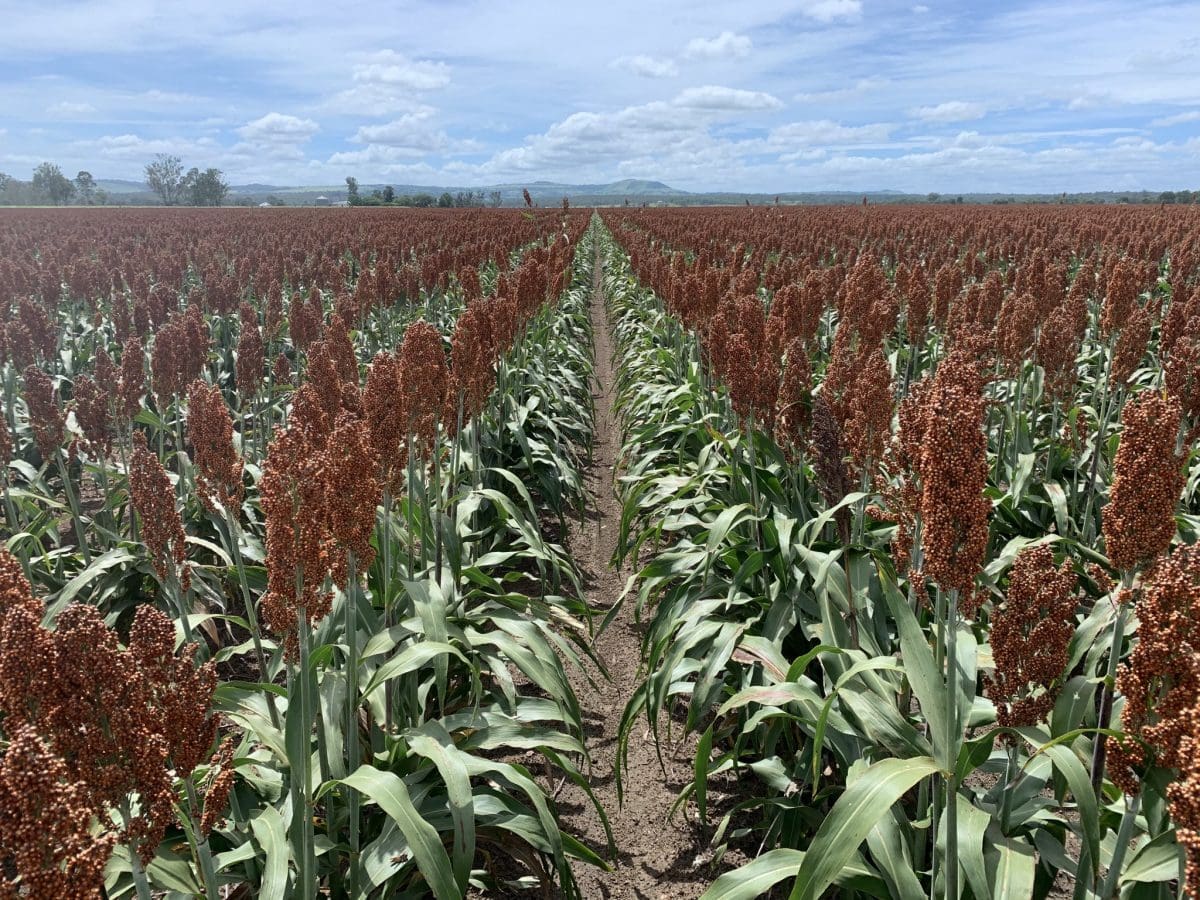
A crop of sorghum at Byee in the South Burnett region of Queensland which was planted in November and started on irrigation. Weather permitting, it will be harvested in coming weeks. Photo: Gary Chesterfield
WHAT a difference a month makes. Substantial rainfall across the majority of nation’s winter and summer-cropping regions over the past four weeks, on top of isolated storms in the preceding five weeks, has swung the mood across rural Australia from one of heightened pessimism to one of guarded optimism.
The vision on our television screens of flooded roads, overflowing gutters, children playing in puddles and farmers dancing in the rain have been a welcome distraction from the summer bushfires and the global coronavirus pandemic.
While there is still a long way to go, the general change to the weather pattern has growers and consumers across the country genuinely excited about crop prospects for 2020, and the possibility of a significant turnaround in domestic grain supply compared with the previous two seasons.
After such a prolonged dry spell, particularly in the eastern states, soil moisture in many regions was at record lows entering 2020. Replenishing those soil-moisture reserves will be a long process, with above-average rainfall required for a prolonged period of time.
The recent widespread falls have started the process of reducing the significant rainfall and soil-moisture deficits accumulated over the last couple of years. However, despite substantial registrations in many locations, most were still below the long-term average for the December-to-February period.
Rainfall has not been confined to the cropping regions. Drought-affected pastoral districts have seen an unbelievable turnaround in pasture growth and feed availability. This comes after most graziers were forced to substantially reduce stock numbers during the drought as the cost of maintaining livestock became prohibitive.
Graziers are now looking to restock as quickly as possible to utilise the abundant forage. The challenge here is the rains have been so widespread that the demand for restocking quality sheep and cattle is unprecedented. It has forced the price of store stock in saleyards across the country to extraordinary levels.
Big mixed-farming potential
Many livestock producers who have the option of planting a winter crop are looking to sow paddocks that haven’t seen a tractor for many years, as the costs involved in buying stock makes growing a crop a much better financial option this season.
Growers with mixed-farming enterprises will almost certainly have an extra paddock or two allocated to winter crop when planting commences, as their livestock numbers are well below normal. This means the potential area available for winter cropping in the eastern states of Australia in 2020 will be substantially higher than in recent years. The potential for a big crop is building, but there is still a very long way to go.
Sorghum sub par
In Queensland and northern New South Wales, the limited area sown to sorghum this summer now has a genuine shot at achieving average yields, assuming regular rainfall continues for the balance of the growing season. As the planting rains came so late, it is extremely difficult to get an accurate handle on the actual area sown. Suffice to say it was well below the total area growers intended to plant if the rains had been timelier.
At this stage, total production in central Queensland, southern Queensland and NSW are estimated to be 250,000t tonnes, 125,000t and 75,000t respectively. That comes to a total of 450,000t and would make it the smallest Australian sorghum harvest since the 1969/70 season.
One of the biggest challenges of a late-sown sorghum crop in southern Queensland and northern NSW is the autumn-winter harvest. Getting grain moisture readings down to acceptable levels can be a challenge as the days are quite short, there is invariably a morning dew, and the daytime temperatures are much cooler. The harvest also tends to occur when the winter crop is being planted, which strains farm resources and challenges management priorities.
China awakes
In international sorghum news, the United States Department of Agriculture (USDA) has revealed, via its daily reporting system, that China has purchased 110,000t of sorghum. The global trade has been waiting for news of grain sales to China as a sign that it was starting to fulfil the Phase 1 commitments it signed off on in mid-January.
Last week’s transaction is the first single sale of more than 100,000t of any agricultural commodity to China since the trade deal was signed. As part of the continuous disclosure regulations in the US, exporters must promptly report such transactions, commonly referred to as flash sales. Sales of smaller amounts only have to be reported on a weekly basis.
According to USDA export data, China has booked more than 475,000t of sorghum this marketing year. However, that total does not include sales of 325,00t to unknown destinations in the third week of February. Sales tagged accordingly are usually destined for China, and the trade is confident they were the buyer in this instance.
The USDA estimates that the US farmer planted 1.9 million hectares (Mha) of sorghum last summer. This is 7 per cent lower than the previous two seasons and is well down on the peak of 6.7Mha back in 1986/87. Production in that year was just short of 29Mt, compared with 8.7Mt this marketing year.
China has been a traditional destination for Australian sorghum in recent years, particularly for the baijiu market, but one thing is certain: Australia will not be challenging the US for bulk sorghum business into China in 2020.
Grain Central: Get our free daily cropping news straight to your inbox – Click here

HAVE YOUR SAY